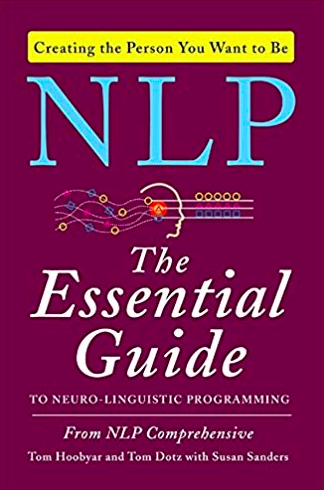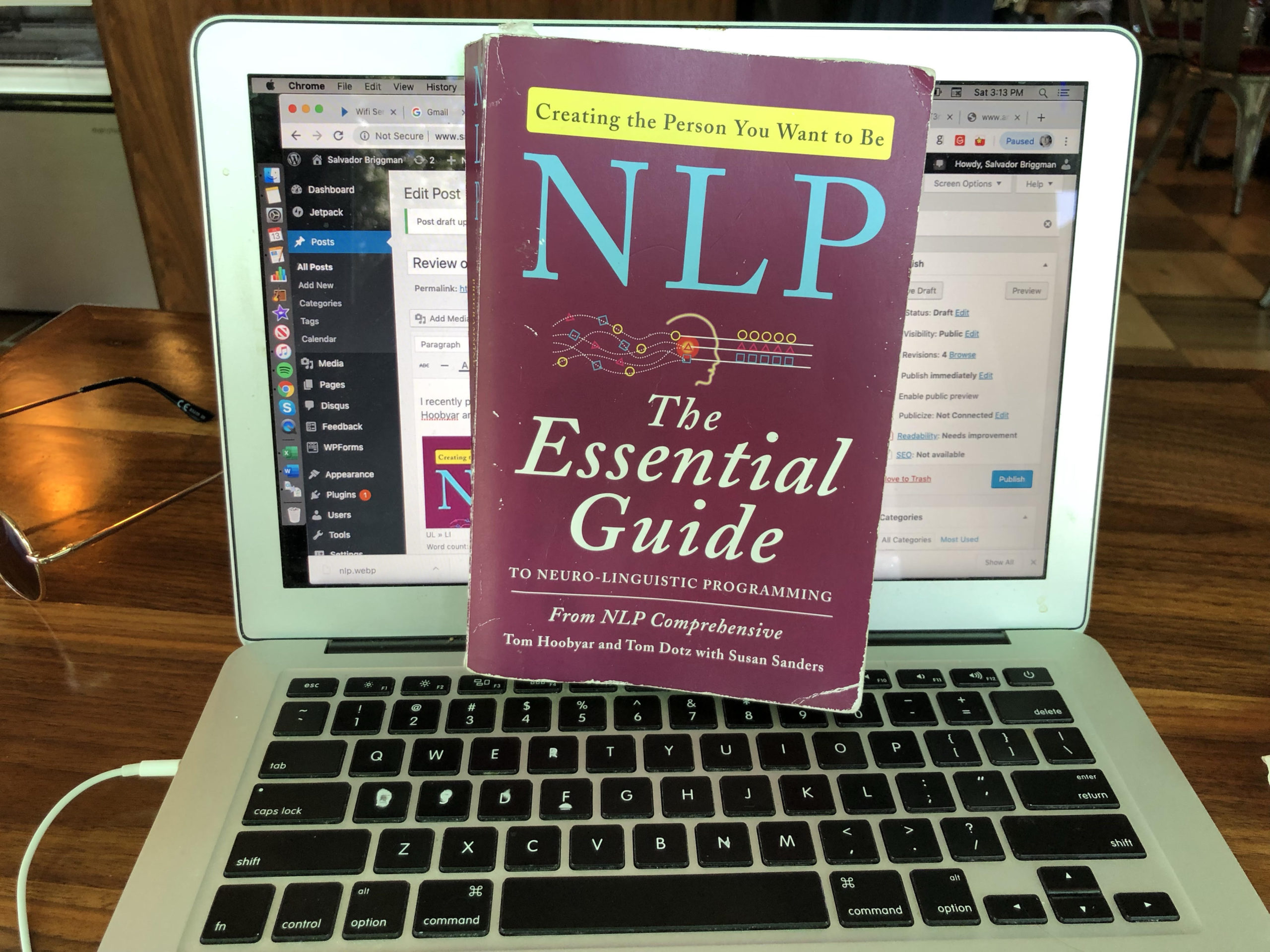I recently picked up a copy of NLP: The Essential Guide to Neuro-Linguistic Programming by Tom Hoobyar and Tom Dotz with Susan Sanders.
 I’ve always wanted to learn more about NLP. It seemed like the mysterious possible pseudo science that was behind the teachings of big-name motivational influencers like Tony Robbins.
I’ve always wanted to learn more about NLP. It seemed like the mysterious possible pseudo science that was behind the teachings of big-name motivational influencers like Tony Robbins.
When I got interested in learning more about dating/PUA, then NLP came up again. When I learned about copywriting and advertising, NLP came up again!
It seemed like this body of knowledge was behind many of the subjects I found interested. I wanted to discover what it was for myself.
Anytime I looked up NLP online, explanations either seemed kind of vague or riddled with so much stuffy jargon that didn’t really explain what it was all about.
This is a thick book and it’s chocked full of valuable information on how human beings think. I’ve found that NLP is the study behind how our minds come to have thoughts, create emotions, and form beliefs.
It’s about the micro-level thought process that we go through each day. It explains how we come to have particular perspectives, beliefs, and even emotional patterns.
I found it fascinating and I recommend that anyone who’s interested in how your mind works should pick up a copy. I”ll include some of my notes below.
Notes on NLP
- NLP is the study of the process of human thought. What goes on when we think. The step-by-step activity of thinking.
- How your mind and brain works and creates your experience of life.
- People do things (good or bad) because some part of them thinks it’s essential. Needed for survival or well-being.
- No matter how strange a behavior, there is an inner logic where it makes sense for that person.
- There is no such thing as an inner enemy.
- Behind every behavior is a positive intention.
- All human thinking occurs in one of the five senses. Pictures, sounds, feelings, smells, and/or taste. Try to have a thought that’s not one of these.
- Senses = modalities.
- Sub-modalities are qualities within those senses.
- Stimulus comes in and you assign meaning to it. You have an emotion. Those emotions generate your reaction.
- Beliefs are so strong that they alter what you perceive.
- When mind is on auto-pilot, it does things without our awareness including:
- Generalization
- Deletion
- Distortion
- An anchor is a cue. Reminds you of something else.
- People respond to map of reality. Not reality itself. Change their inner map, you’ll change their emotions.
- The way we communicate with ourselves creates personal experience. The way we communicate with others determines the way we are treated throughout our lives.
- If it’s possible for one person to do something, it’s possible for anyone to do it through modeling.
Good Questions to Ask
- What stops you from having your desired outcome?
- What resources do you need to help you create what you want?
- What will ___ do for me?
- What will I see, hear, or feel when I am feeling and being more ___. What might others notice?
More Notes
- Learn to detect when not being congruent.
- Having something to look forward to gives me and most people a senes of direction and purpose.
- Find the moment that you went from intending to do, to doing something else, and find the sequence of pictures, sounds, and/or feelings that you experienced.
- Slow down mental movie and run it in slow motion. Confused usually means angry or afraid. There is a feeling under the confusion.
- Anxiety, jealousy, fear, and irritation are visually oriented. Depression, discouragement and downbeat feelings are auditory queue from voice in head.
- Curiosity blocks self-talk and images. It opens you up to new possibilities.
- Depression is illogical and is personal, pervasive, or permanent thoughts. Takes discouragement and makes a habit out of it.
- Panic mode shuts down critical and deliberate thought. Meditation creates benefits in sense of reality.
- Meditation is a great way to slow your brain down so you can observe your thoughts, where they come from, how they form, what comes up.
- Don’t get hooked into inner dialogue. Just let the thoughts pass by.
- Beliefs formed in early childhood are generally the result of learning from our parents and our environment how to survive in the world.
- Notice beliefs when you say “I should do…” “I ought to do… “”Must..cann…” Simply ask yourself “according to whom?” or “who says.”
- Listen for generalizations like all, every-time, always.
- Preferred way of processing (visual, auditory, kinesthetic.)
- You will make changes when you feel a crisis in identity or self-concept. Life transitions can provoke self-examination. Changes like divorce, marriage, childbirth, career, etc.
- How belief comes about.
Enough experience or enough people comment on this thing and you have evidence, so you generalize.
How many bits of evidence or memories do you have to support the belief? - Counter examples to your belief “evidence” will weaken your self-concept. It undermines self-concept, creates incongruity, and weakens person.
- Too many counter examples will threaten or destroy a self-concept.
- To strengthen a self-concept, convert counter evidence to “oh and this learning experience makes you this way even ore now.”
- Pick trait you want to have. Go back in memory and notice the times you have been that person or you have been that way.
- When you think of interacting or spending time with me, what do you like best about that? What’s one thing you’d like me to keep doing?
- If you could change one thing about how I interact with you, what would that be? You’re important to me and I really want to know. What would you like me to stop doing?
- If you could wave a magic wang to change how I interact with you, what’s one thing you’d like me to start doing?
- Amygdala gets stimulus before the part of the brain that thinks things over. Feel more think less in fearful situations.
- Be aware of where someone is and how resourceful they are in their current state of mind.
- You can be so sympathetic that you can lose yourself a little. Too deeply involved with another person’s feelings.
- You can go to the second position (empathy) to gain information, but you can’t live there. You want to live in the first position and briefly visit the other two.
- What do you like most about that?
- What needs to happen to make that feeling better.
- Matching/mirroring – you are like them and you like them.
- “For that statement to be true, what must be going on inside that person. What’s it like in their world?”
- Without an adult experience that calls belief into question, we can carry thoughts as truths through our whole lives.
- If you have a belief for a long time, you would also have lots of evidence that it’s true, simply because that’s what you’re looking for.
- Stated goal is not real motivation often times. Meta-outcomes.
- “What would happen if that occurred?”
- “What important about that?”
- “If that happened, what would that do for you?”
- “If that happened, what would that do for you that’s even more important?”
- “When you think about going back, what are you most excited about?” “What do you like best about that?” “What’s the best time you’ve ever had on a vacation.”
- Relationship to time.
- Giving someone your full attention makes them feel special.
- Touching will deepen a connection. You will also feel more relaxed because you’ve had contact with them.
- Asking why directly can make someone feel challenged. You can instead say I wonder why that’s so. What do you think ?
- What has to be going on in someone’s world for this to be true for them?
- Beliefs are out of a person’s awareness and are stated as fact. Because these ideas shape the person’s view of the world, they are dearly held and can become a source of conflict.
- Ask them what needs to happen to be in better mood. What shift must occur for them to be in a better mood.
- When people are angry or frustrated, they can’t be curious. Curious equals creativity.
- Take them to the last time they felt this way. Describe so they can feel it again.
- If it were an image, what would it be?
- If you were to ask ___ what frustrates him about working with you, what do you think he’d say. If that’s true, what would that make him want to do.
- Don’t be desperate. Just be willing. The more willing you are, the more it shows you have control of time.
- In negotiation, never humiliate them, make them feel bad, or rob them of face .
- Employ inner dreamer, realist, and critic separately and in sequence. Use these mental roles in a collaborative way.
- Dreamer – one who all things are possible. Who you want to be like? Future. Payoffs.
Realist – sorts things out. What will I do. How implement. How measure. Who else involved. Each phase. Each phase carried out.
Critic – Pieces that don’t fit. How do elements fit together. Are they unbalanced. Which parts don’t fit the objective. Which parts are underdeveloped. Why is each step needed. - If I was to ask ____ what is frustrating about working with you, what would they say. What would that make them want to do?
